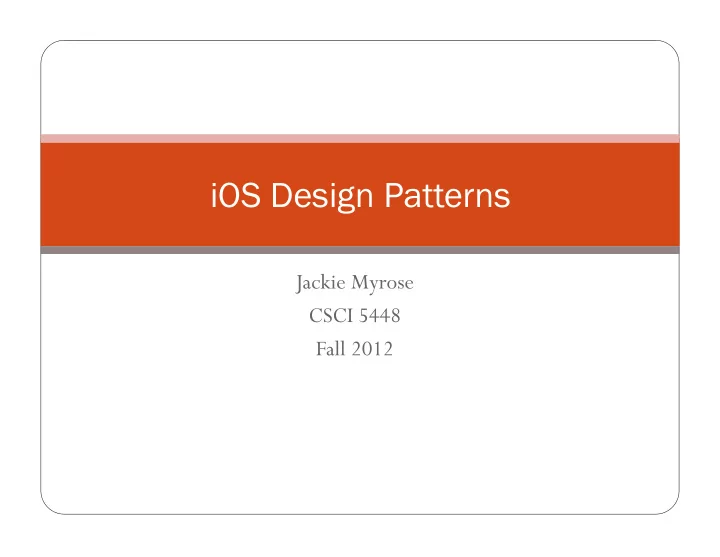

iOS Design Patterns Jackie Myrose CSCI 5448 Fall 2012
Design Patterns A design pattern is a common solution to a software problem They are helpful for speeding up problem solving, ensuring that a developer doesn’t have to re-invent the wheel for every situation They also give developers a common vocabulary with which to get across high-level ideas with minimal explanation and full understanding
Why iOS? Design patterns are everywhere in iOS Because iOS is a fairly specific platform, developers often face similar problems over and over, so there are a few design patterns that are extremely common in iOS
In this presentation Singleton Delegate Model View Controller Observer Façade Command Template Method
Singleton The singleton pattern is very simple but extremely powerful It is a very common pattern, but developers have to be careful not to overuse it Because abuse of the singleton pattern is common, some developers avoid the pattern altogether
Singleton When a class is restricted to just one instantiation, that one object is called a singleton In some situations it can be problematic to have two instances of a class running, this should be the only reason to use the singleton pattern The next slide contains a basic example of creating a singleton in objective-c, however keep in mind that this code is not thread safe
Singleton - code +(ExClass *) singleton{ � � � static ExClass *sharedInstance = nil; � � �� � � if ( sharedInstance == nil){ � � � � sharedInstance = [[ExClass alloc] init]; � � � } � � � return sharedInstance; � } �
Delegate The delegate pattern is another simple, yet powerful design pattern As the name indicates, the delegation pattern is used to have one object delegate control to another object to act on its behalf This is used to keep implementation specific behavior out of the generic class
Delegate Image from: https://developer.apple.com/library/mac/#documentation/cocoa/ conceptual/CocoaFundamentals/CocoaDesignPatterns/CocoaDesignPatterns.html
Delegate Many UI elements in iOS use delegates to control their behavior One example of this is UIScrollView The UIScrollView class has no knowledge of what it should be scrolling as that is an application specific task So to notify the application of scrolling events, UIScrollView uses the UIScrollViewDelegate The application can implement the delegate and then intercept the scrolling events sent to it by the UIScrollView The next slide has examples of methods the UIScrollViewDelegate could implement
Delegate - code UIScrollViewDelegate � - scrollViewDidScroll: � - scrollViewWillBeginDragging: � - scrollViewWillBeginDecelerating: � - scrollViewDidEndDecelerating: � - scrollViewDidZoom:
Model View Controller All iOS apps use Model View Controllers (MVCs) MVCs are the link between an app’s data and its UI The MVC is broken up as such: Model – Underlying data View – The view the user sees, the UI Controller – Determines the interactions between the model and views This keeps the program modularized, allowing for high cohesion and loose coupling
Model View Controller Image from: http://developer.apple.com/library/ios/#documentation/general/ conceptual/DevPedia-CocoaCore/MVC.html
Observer The observer pattern is used when one object wants to know when another object changes This pattern is build into every NSObject vi Key-Value Observing This is also often used with MVCs because when a model changes you often will want to update the views
Observer Image from: http://www.dofactory.com/Patterns/PatternObserver.aspx
Observer The observer pattern is similar to the delegate pattern, however one key difference is that observable objects support multiple observers, while a delegate is just one object However, with this expanded possibility comes one big pitfall: you must remember to remove an object as an observer when that object is deallocated, otherwise there will be a code leak The following slide contains a code sample of what the Observable class looks like
Observer - code @interface Observable: NSObject � - (void)addObserver: (id<NSObject>)observer; � - (void)removeObserver: (id<NSObject>)observer; � - (void)notifyObservers: (NSInvocation*)invocation; � @end
Façade The façade pattern is used for simplifying a complex system It allows for a subsystem to be accessed through one entry point, allowing the systems using it to be unaware of the classes in the subsystem This is also useful if the classes under the façade are likely to change, as we can still have the façade class have the same API
Façade One example of this in iOS is the NSImage class This class is a façade which provides an interface for using and loading images that can be vector-based or bitmap-based So no matter what type of image the application is using, it can use NSImage and have no knowledge of what’s happening underneath the class
Façade Image from: http://www.tutebox.com/2066/computers/ programming/design-patterns-facade-pattern/
Command The command pattern is used for request encapsulation It allows for the separation of an object sending a message from the objects receiving the message The encapsulated request/message is then much more flexible and can be passed between objects, stored for later, dynamically modified, or placed on a queue
Command In iOS an example class that is used to encapsulate messages is NSInvocation These objects are used for undo management They contain a target, selector, arguments, and the return value These elements can be set directly and the return value is set automatically when the object is dispatched
Command Image from: http://developer.apple.com/library/ios/#documentation/Cocoa/ Conceptual/CocoaFundamentals/CocoaDesignPatterns/CocoaDesignPatterns.html
Template Method The Template Method design pattern defines the skeleton of an algorithm, leaving some parts to be implemented by subclasses This allows subclasses to refine certain parts of the algorithm without changing the structure In iOS this lets parts of a program “hook” into an algorithm, but the framework still determines how they are needed
Template Method One example of this in iOS is the document architecture defined by AppKit, a framework Three classes are key to this architecture: NSDocument, NSWindowController, and NSDocumentController AppKit sends messages to each of these objects at runtime and then requests it to perform specific operations The developer needs to override many methods in these messages to add behavior specific to their application
Template Method Image from: http://java.dzone.com/articles/design-patterns-template-method
Further Resources https://developer.apple.com/library/mac/ #documentation/cocoa/conceptual/CocoaFundamentals/ CocoaDesignPatterns/CocoaDesignPatterns.html http://www.amazon.com/Pro-Objective-C-Design- Patterns-iOS/dp/1430233303
Recommend
More recommend